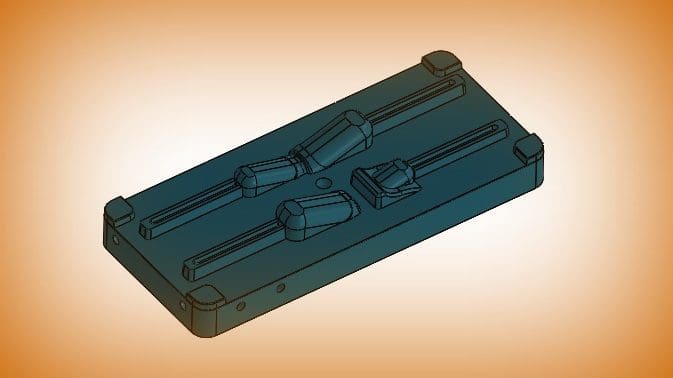What do you do when you have a part to be injection molded, but it needs to be in a couple of slightly different sizes? Or, how about having different versions of a part where some features move locations or change just a bit? In other words, what are the tooling options for similar but differing parts? Of course, you can’t change the size or configuration of a steel mold… Or, can you?
Naturally, one approach to molding different, but not identical, parts is to build separate molds for each. Alternatively, a family mold with cavities and cores for each part could be built, too. However, one option is to build only one mold that has interchangeable inserts.
A plastic injection mold with interchangeable inserts has different, removable, internal cavities and cores that bolt into the mold base. This can be a cost-effective approach to tooling and molding for multiple parts with slightly different sizes and configurations.
One of the clear cost savings regarding tooling comes from the fact that only one mold base and set of internal components has to be purchased, although the materials for each cavity and core must be obtained (of course). Also, the mold builder doesn’t have to perform all the work to fabricate several different molds but only needs to create one plus the necessary inserts. So, the time and labor to build one mold with interchangeable inserts should be quite a bit less than it would be to make many complete molds.
On the manufacturing side, having one mold that produces a part with multiple variations by using different inserts can save time on production, because only one complete mold set-up is required. Obviously, the inserts need to be changed between production runs, but that generally is much quicker than taking a mold out of a machine and installing a completely new one, considering all that entails (e.g., placing the mold in the machine with a forklift or crane, hooking up water lines).
While interchangeable inserts may present some advantages to other methods toward molding similar parts, there are some caveats to keep in mind. First, not all parts with related features are good candidates for this approach, because their unique geometries might preclude it for some reason. Additionally, when utilizing interchangeable inserts, the different parts will be produced consecutively, whereas they would be made concurrently using a family mold, for instance. So, the manufacturing time will be longer, which might affect part prices. Also, if the demand is too high for the parts, this method might not be practical, although it may fit into a bridge tooling approach nicely, at the beginning of a program.
Further, if you are considering having a mold with interchangeable inserts built, make sure the inserts can be changed while the mold is in the molding machine, if at all possible. If the mold needs to be removed from the machine, taken to the tooling department for the insert change, and then brought back to the production floor and re-set up, that clearly requires additional, wasted labor and time, which eliminates much of the manufacturing efficiencies achieved otherwise.
In sum, for a part with several similar versions and relatively moderate production demand, building and using a plastic injection mold with interchangeable inserts sometimes provides certain efficiencies and economies. Accordingly, keep the option in mind in case the opportunity ever presents itself.
If you would like more information on this subject or on anything else related to plastic injection molding, visit our Resource Center or please don’t hesitate to contact us. We look forward to speaking with you.

